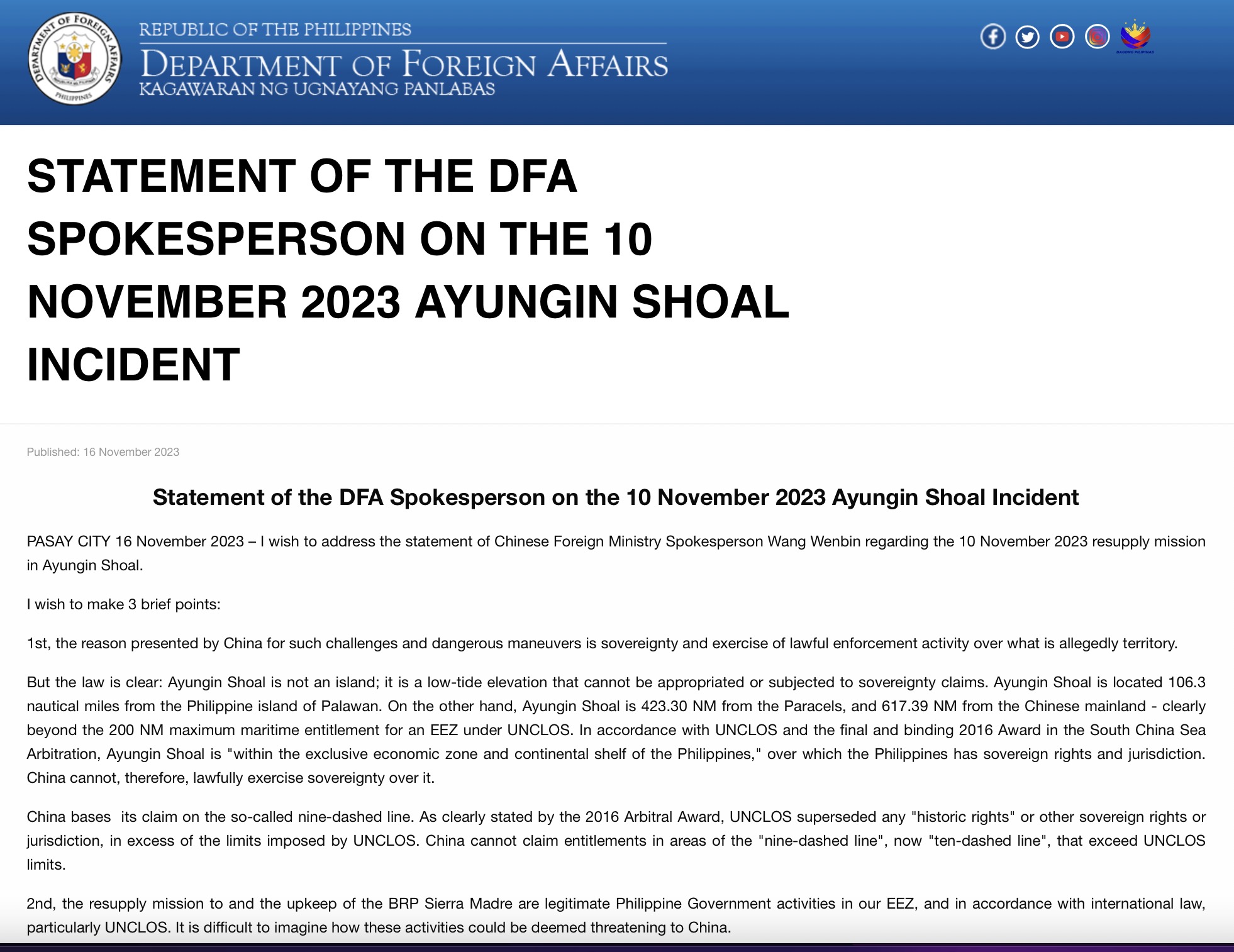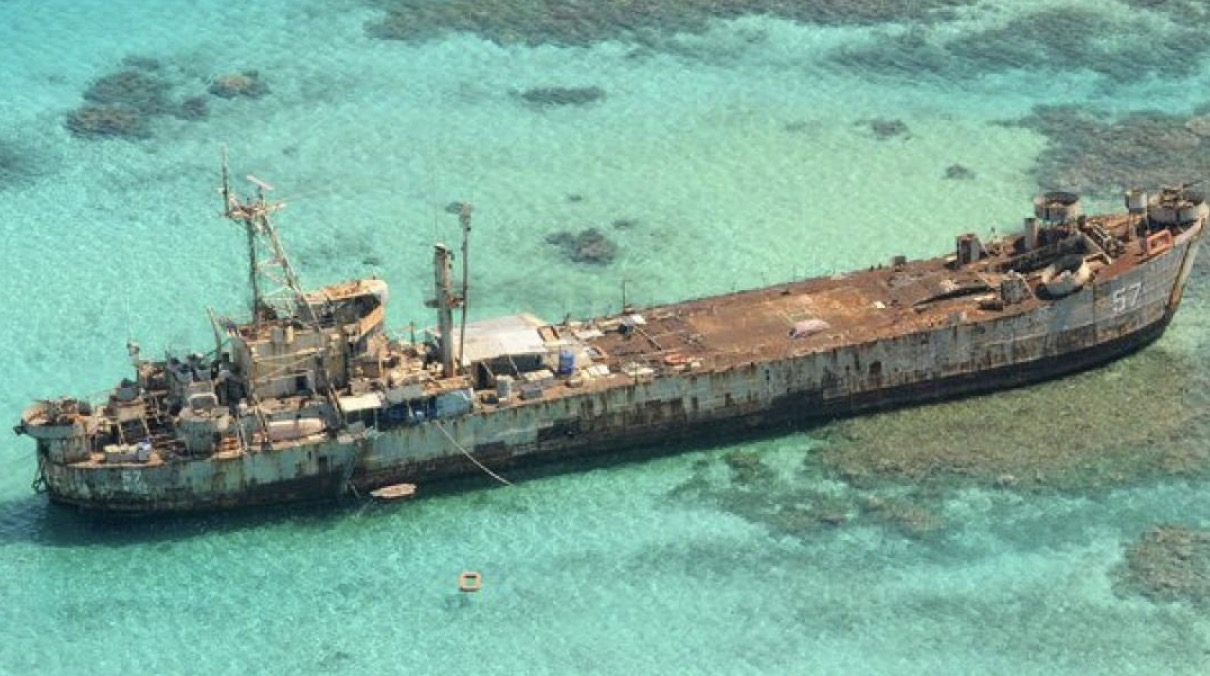Over the past few years, perhaps no warship in the world has garnered as much international attention as the BRP Sierra Madre. The controversies surrounding its resupply operations and the rotation of personnel have sparked a series of incidents—alleged laser targeting, water cannon attacks, ship collisions, and aerial drops —which have amplified global concerns over the situation in the South China Sea. However, amidst the noise, fundamental questions regarding the legal status of the BRP Sierra Madre remain inadequately explored. Notably, is the Sierra Madre still a warship? If not, what is its current legal status? Resolving this legal ambiguity is essential for understanding the rights and obligations of the parties involved and for determining the applicable framework of international law.
The Philippine government has employed a number of contradictory formulations in its discourse on the status of the BRP Sierra Madre.[1] The BRP Sierra Madre is sometimes referred to as 'a commissioned Philippine naval vessel', and at other times, the term 'active' is added when 'commissioned' is deemed insufficient. Additionally, the BRP Sierra Madre is sometimes described as a 'constant Philippine presence' or a 'permanent station' on Second Thomas Shoal.[2] The Philippines typically considers the BRP Sierra Madre to be both a 'commissioned naval vessel' and a 'permanent station' on Second Thomas Shoal. However, this appears to be a contradiction in terms, as a warship should not be considered a 'permanent station', and a 'permanent station' cannot be a warship.

The Philippines' dual characterization of the BRP Sierra Madre may serve a strategic purpose. By claiming that the vessel is an active warship, the Philippines may seek to invoke the protections afforded to warships under article 29 of the United Nations Convention on the Law of the Sea(the Convention), such as immunity from seizure or attack. Simultaneously, by describing it as a permanent station, the Philippines may aim to establish a long-term occupation over Second Thomas Shoal, challenging China's territorial claims in the South China Sea.
However, these designations are fundamentally incompatible. The BRP Sierra Madre is a World War II-era vessel, is no longer seaworthy and has been grounded for over two decades.[3] It has clearly lost its ability to function as a naval vessel. There is no precedent for using a beached warship to establish permanent territorial claim. The Philippines' contradictory assertions reveal its strategic ambitions while also highlighting the legal and factual inconsistencies in its position.
The question thus arises as to the precise nature of the BRP Sierra Madre. On what grounds should its legal status be evaluated? What is the rationale behind the Philippines' elaborate semantic packaging of the BRP Sierra Madre? Does the BRP Sierra Madre have immunity under article 32 of the Convention? Should China forcibly tow or dismantle the Sierra Madre, would the Philippines be justified in invoking its right to self-defense? And would the United States be obligated to defend the Philippines under the terms of the US-Philippines Mutual Defense Treaty? These questions merit serious consideration. Due to space constraints, this article will focus exclusively on the legal status of the BRP Sierra Madre. Subsequent article will delve into the issues of immunity, self-defense, and the obligations of the United States.
Is the BRP Sierra Madre still a warship?
In accordance with Article 29 of the Convention, a warship must meet five criteria:(1) It must be a ship; (2) It must belong to the armed forces of a state; (3) It must bear external markings identifying its nationality; (4) It must be commanded by a commissioned officer of the state; (5) It must be manned by a crew that is subject to the discipline of the regular armed forces.[4] Central to this definition is the assumption that a warship is a vessel capable of navigating the seas. [5]

The BRP Sierra Madre has been stranded on Second Thomas Shoal for over two decades, rendering it immobile. Physically, it now serves as living quarters for the Philippine Marines stationed there. Its current function as a military outpost further deviates from the traditional characteristics of a warship.
Moreover, the BRP Sierra Madre's physical condition is severely compromised. The vessel's hull is riddled with damage, including large holes and water ingress.[6] This extensive deterioration has resulted in a complete loss of buoyancy and seaworthiness, making it impossible for the BRP Sierra Madre to function as a floating device.
Additionally, the Philippine government has taken steps to reinforce the BRP Sierra Madre's position on Second Thomas Shoal, effectively anchoring it to the reef.[7] This action further solidifies the vessel's status as a fixed, non-mobile structure.
Article 29 also requires that a warship be manned by a crew subject to military discipline. While the marines currently serving on the BRP Sierra Madre are members of the regular Armed Forces of the Philippines (AFP) and are subject to AFP discipline, the Philippines has not provided the BRP Sierra Madre with a crew that meets the standards set out in Article 29 of the Convention.[8] It would appear that the Philippines has not complied with the requirements of Article 29 of the Convention for a considerable period of time. It is not unexpected that the crew would be responsible for ensuring the safe navigation of the ship. The BRP Sierra Madre has been moored for an extended period with no navigational capability. It would appear that the crew is superfluous.
It should be noted that the mere inclusion of the BRP Sierra Madre in the Philippine Navy's active roster does not automatically confer upon it the status of a warship. Its status must align with the criteria set forth in Article 29. As it stands, the BRP Sierra Madre's loss of seaworthiness, fixed position and repurposing as a military outpost render it incompatible with the traditional concept of a warship. This makes the Philippines' insistence on its warship status a clear violation of international norms.
Is the BRP Sierra Madre a “permanent outpost” of the Philippines on Second Thomas Shoal?
A military outpost is typically a small, remote military installation located at the edge of a country's territory. Its purpose is to monitor and protect national borders from potential threats or incursions. A 'permanent outpost' must be based on its own legitimate territory and should not be an illegal presence on the territory of another state.
The Philippines initially ran the BRP Sierra Madre aground on Second Thomas Shoal, citing mechanical issues as the cause. However, the country subsequently failed to honour its commitment to tow the damaged vessel away.[9] Following the signing of the Declaration on the Conduct of Parties in the South China Sea (DOC) in 2002, the Philippines made a commitment not to construct fixed installations on Second Thomas Shoal.
Furthermore, the country has provided repeated assurances that it will not replenish construction materials. For instance, in September 2003, Acting Foreign Minister Franklin Ebdalin stated that the Philippines had no intention of building facilities on Second Thomas Shoal and that the Philippines, as a signatory to the Declaration, would not be the first to violate it.[10]
Since 2010, the Philippines has persistently sought to reinforce and refurbish the BRP Sierra Madre, thereby creating complications and attempting to further alter the status quo on Second Thomas Shoal unilaterally.[11] This constitutes a breach of the DOC's Article V commitment to exercise restraint and refrain from the occupation of uninhabited reefs.
On the other hand, as recently as 2015, the United States did not recognize the BRP Sierra Madre to be an official Philippine military installation.[12] It was only in the last two years, as U.S.-China tensions escalated, that the U.S. began describing the BRP Sierra Madre as a 'longstanding outpost' of the Philippines.[13]
The Philippines' portrayal of the BRP Sierra Madre as a 'permanent outpost' seems clearly intended to justify its permanent occupation of Second Thomas Shoal. However, given the Sierra Madre's dilapidated condition and its age, Manila cannot realistically rely on it for a sustained occupation.
Moreover, the Philippines' stance that 'Second Thomas Shoal is a low-tide elevation that cannot be appropriated' contradicts its claims of a permanent presence. If the Philippines genuinely believed Second Thomas Shoal was part of its exclusive economic zone (EEZ) or continental shelf, it could legally construct temporary facilities without needing to 'occupy' the area.
The prolonged beaching of the BRP Sierra Madre on Second Thomas Shoal is essentially a disguised act of territorial expansion. This infringes on China's territorial sovereignty and violates the DOC. It has also met with sustained and resolute objections from the stakeholder. Therefore, it is not possible for this illegal presence to become a 'permanent post', either de jure or de facto.
In conclusion, the Philippines is attempting to exploit the legal ambiguity to advance its territorial expansionist agenda by issuing contradictory statements regarding 'a commissioned warship,' 'a permanent station,' and 'low-tide elevation that cannot be be appropriated or subjected to sovereignty claims'. This strategy to disguise its territorial expansionist intentions by exploiting legal ambiguity is simply an attempt to conceal its true motives. Such disingenuous behavior must be scrutinized and addressed.


